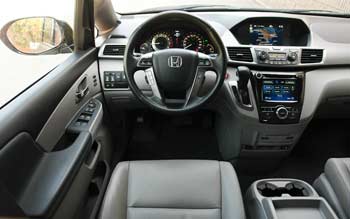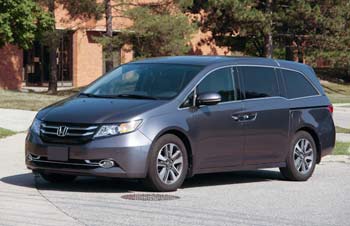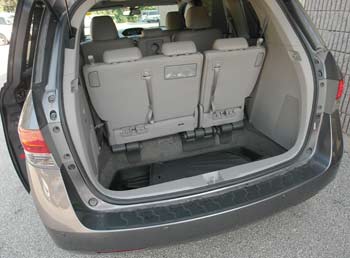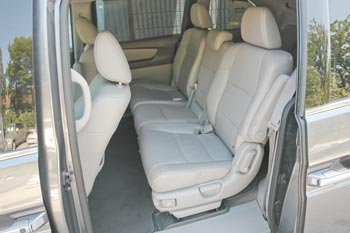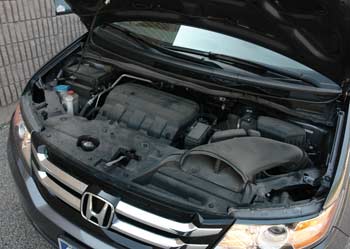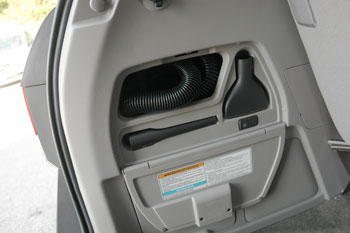Honda Odyssey 2011-2017: pros and cons, common problems
By Vlad Samarin Updated: September 24, 2023
The Honda Odyssey gets its name from an ancient Greek legend about an epic journey. Does the car live up to this elegant name?
The sleeker styling of the Odyssey makes it feel like less of a minivan and more like a bullet train.The ride is smooth and quiet, and you won't be disappointed by the 248-hp 3.5L V6 engine. Inside, the Odyssey is spacious even for those sitting in the third row, and comes with nifty features such as a removable second row. Let's start with pros and cons:
Pros:
- Above-average reliability, can last for over 200,000 miles.
- Smooth and quiet ride, good handling.
- Comfortable and spacious interior.
- Removable 2nd row seats, can fit a 4 ft. x 8 ft sheet of plywood.
- Excellent safety ratings.
- Good V6 engine can last long and is good for towing.
- The weight of a heavy V6 engine over the front wheels improves traction in snow.
Cons:
- Interior fit and finish could be better and plastics seem lower quality.
- Some drivers have reported lower than advertised fuel economy.
- Only one engine option.
- Sliding doors need delicate care to avoid problems.
- No button to turn off VCM.
- Comes with a timing belt that needs to be replaced around every 100K miles.
2011-2017 Honda Odyssey Reported Problems:
It's worth noting that even though the Odyssey is the best-selling minivan, we have found a relatively low number of reported trouble spots. Generally it's a reliable vehicle with a good engine that can last for over 200,000 miles. Of course, given that it's a complex vehicle with many features, it will need some repairs here and there and some repairs could be pricey.The intake rubber tube that connects the air filter box to the throttle body is known to crack and leak. If the damage is bad enough, it could cause the car to stumble on acceleration. The solution is to replace the intake tube, which is a cheap part. The crack is typically visible once you open the hood. Here is the photo of a cracked intake tube.
An alternator can fail, often as a result of an oil leak from the VTEC spool valve that is located near the oil dipstick, or the valve cover gasket. Repairing this oil leak may prevent alternator failures in the future. Watch these videos describing the problem and repairs. If you notice that the alternator looks covered in oil, have the oil leak repaired before the alternator fails. The alternator is located under the oil dipstick.
Owners have reported a popping, knocking or creaking sound from the front of the minivan, typically when turning at low speeds. According to Honda Technical Service Bulletin 11-038 for the 2011 and some 2012 Odysseys, a bump stop touches the top of the front damper (strut) or the damper shaft self-locking nut has low torque, causing these symptoms.
The TSB states that special grease will need to be applied to the top of the front dampers, and the front damper self-locking nuts will need to be re-torqued for 2011 models. The fix is simple and inexpensive. More information about it can be found in this forum post and these YouTube videos. Always have odd noises such as rattles or clunks coming from under the car diagnosed as soon as possible to keep your car safe.
According to the Honda TSB 17-043 and 17-044 on the NHTSA website, deteriorated transmission fluid can cause a judder while driving between 20-60 mph in the 2014-2017 Odyssey. Once diagnosed, a software update may need to be performed and the transmission flushed.
According to the bulletin, the "flushing" refers to repeatedly draining and filling the transmission with Honda Genuine ATF-DW1. The warranty information on the TSB is listed as 8 years or 80,000 miles, whichever comes first. Out of warranty, it can cost about 1 hour of labor plus the cost of fluid and diagnostics if needed. See this owner's forum thread for more details. The 2012-2013 Odyssey Touring and Touring Elite have the same issue covered by TSB 17-052.
Owners of the 2011 Odyssey have reported the "Battery Charge Low" indicator coming on despite the battery being OK. According to the TSB 11-0730, a software update for the battery sensor may be needed to improve the accuracy of the Low Battery warning. This repair is inexpensive. The bulletin also states that this fix will not improve vehicles not driven regularly or long enough to recharge the battery, or if there are aftermarket accessories causing a high-current draw problem.
According to the TSB 14-009 for the 2011-2013 Odyssey EX-L and Touring, a broken seat-back heater element can cause the driver's seat heater to shut off seconds after being turned on. The element may need to be replaced, costing $280 to $360. See this thread for more details.
A bad oil pressure switch can cause the codes P3400 (rear pressure switch, bank 1) or P3497 (front switch, bank 2). The repair is fairly simple and the parts are not expensive. Check out these YouTube videos detailing the front and rear sensor replacements. These codes do not necessarily mean that an oil pressure switch is the problem; have them properly diagnosed first.
Sliding doors: A damaged or broken cable can cause the automatic sliding doors (available in upper Odyssey trims) not to work. The actuators can also fail, but owners have reported that the cable is the most frequent trouble spot. Getting it fixed by your dealer can cost from $900 to $1150. Some owners have opted to replace the cable themselves to save on repair costs, but the fix is tedious and time-consuming. You can find more information about it in this thread and in these YouTube videos.
Another trouble spot is the middle (center) hinge with sliding door roller. If it fails or deforms, the sliding door could be difficult to open or close. Replacing this part is not too difficult. It's a good practice to keep all sliding door rails clean and the door hinges/rollers lubricated. Watch these videos describing the repair.
A bad TPMS sensor can cause the TPMS light to stay on. Replacing a sensor costs from $100 to $180.
The codes P0301, P0302, P0303 or P0304 can be caused by bad ignition coils, fouled spark plugs or by oil leaking into the spark plug wells from bad valve cover gaskets. The repair will depend on the diagnosis. At higher mileage, the spark plugs may need to be replaced more often.
Check for any recalls on the NHTSA website.
Summary
The Odyssey is still the best minivan on the market. It can last of over 200,000 miles with proper maintenance. It's roomy and offers plenty of cargo space. Of course, it's a complex vehicle, and it will need some repairs over time. Consider getting an extended warranty. Sliding rear doors need gentle care as well as regular lubrication of the latch and sliding mechanism to avoid problems. Overall, it's a good vehicle. In NHTSA crash tests, the 2011-2017 Honda Odyssey scored perfect 5 stars for front and side impact crash tests, and 4 stars for rollover.Related posts:
Mazda 5 2006-2015
Honda Pilot 2009-2015
Mazda CX-9 2007-2015
Dodge Journey 2009-2020
Nissan Pathfinder 2013-2019
Does the 2011-2017 Honda Odyssey engine have a timing belt or chain?
All 2011-2017 Honda Odysseys have a timing belt that must be replaced at regular intervals. According to the Honda Owner's Manual, the belt should be replaced when indicated by the Maintenance Minder (under Maintenance Sub Item 4). Most of the times the Maintenance Minder Sub Item 4 code comes on at around the 100,000 miles mark. If the car is regularly driven in extreme temperatures, the belt must be replaced every 60,000 miles/100,000 km.Advertisement
Changing the timing belt is a precise job and should be done by a professional. We also recommend using good quality parts for this repair. When changing the timing belt, the water pump is also typically replaced since it doesn't require too much of extra labor. The timing belt replacement can cost from $680 to $1,100.
2011-2017 Honda Odyssey Engine and VCM system:
The 2011-2017 Odyssey only comes with the solid 3.5L V6 J35Z8 engine, which uses VCM (Variable Cylinder Management) technology. The purpose of the VCM is to improve gas mileage by shutting off 2 or 3 cylinders in certain driving conditions.For example, as you are cruising down the highway, the VCM will deactivate a few cylinders, until you decide to pass the slow driver in front of you, reactivating the cylinders for passing power. Here is a video by Honda illustrating the technology. We have found that some owners have mixed feelings towards the VCM feature, citing it as a cause of excessive oil consumption and fouled spark plugs.
Fuel Economy:
The 2011-2013 Honda Odyssey with a 5-speed automatic transmission gets 18/27 MPG City/Highway, getting 441 Miles/710 km on a tank. The 2011-2017 Odyssey with the 6-speed automatic transmission scores 19/27 MPG City/Highway, getting 462 miles/744 km to a tank.What to look for when buying a used Honda Odyssey:
Check the oil level, is it low (may indicate high oil consumption)? Has the timing belt been changed (it's a costly repair that may need to be done)? If it comes with power sliding doors, make sure that they open and close smoothly without any abnormal noises. If a power sliding door breaks, the repair is expensive.Check the power tailgate and moonroof, if available. Listen for any odd noises such as rattling, clicking or popping on your test drive. Check the front and back air conditioning, as well as the heated seats.
Avoid the vehicle if the check engine light stays on, or if the transmission does not shift smoothly or shows hesitation. We recommend opting for the 2014-2017 Odyssey, as earlier years seem to have slightly more issues.
